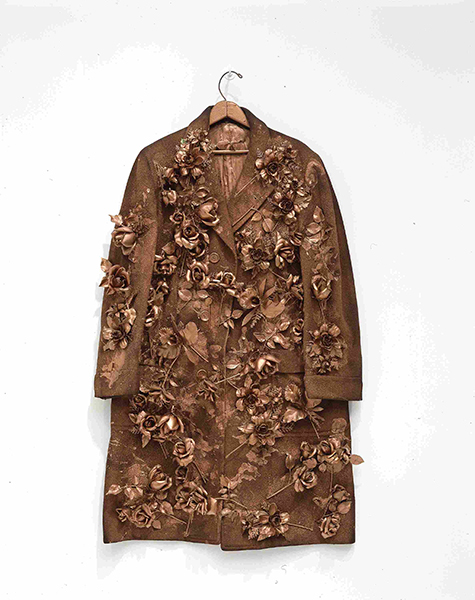Disability Pride Month 2022: Yayoi Kusama
During her long and distinguished artistic career, artist Yayoi Kusama has explored painting, sculpture, conceptual art, performance art, and installation with sound. She has created a truly unique aesthetic vision for generations to come.
 |
| Yayoi Kusama (born 1929, Japan), Flowers – Overcoat, 1964. Cloth overcoat, plastic flowers, metallic paint, 50 ¾" x 28 7/8" x 5 ¾" (128.9 x 73.3 x 14.6 cm). Courtesy of the Smithsonian Hirshhorn Museum and Sculpture Garden, Washington, DC. Art © Yayoi Kusama. (SI-616) |
Along with polka dots, flowers have played an integral part of Kusama's work throughout her career. The first known photograph of Kusama dates from 1939. It shows her small face surrounded by a bouquet of giant dahlias. It is almost as if her face becomes one with the giant flowers. The plastic flowers adorning the common raincoat in Flowers – Overcoat present a banal subject that prefigures similar work by the German conceptual artist Josef Beuys (1921–1986).
Early in her career, while in New York in the early 1960s, Kusama was primarily known for her “happenings” (performance art). Kusama used clothing as her “support,” producing conceptual works that mirrored the obsessive use of flowers and dots that are the primary forms in her paintings. It is not unusual that art and fashion often feed off one another.
In 1969, Kusama opened her own “fashion line,” although many of the pieces shared the same tongue-in-cheek style as Flowers – Overcoat. Many of her fashions were meant to make a political statement, generally through holes that were strategically placed in the garment, making it not practical to wear in public.
A pioneer of Japanese modernism, Kusama was born in Matsumoto City. She was raised in a conservative, strict, some would say abusive, household. Despite her parents’ traditional values, Kusama was producing watercolors of polka dot and net motifs as early as the age of ten. She has explained that, even as a child, she experienced auditory and visual hallucinations with elements of nature, which she would immediately rush home and draw.
In 1948, Kusama started formal art training in Kyoto. She was taught the conservative nihon-ga (Japanese style), a style that was an attempt by certain Japanese artists to maintain traditional Japanese styles and subject matter with limited influences from Western art.
Rejecting the rigidity of the genre in 1952, Kusama began to study Western modernist styles in magazines, including Surrealism, Cubism, and the paintings of Georgia O'Keeffe (1887–1986), absorbing these styles into her own work. She even began corresponding with O'Keeffe. The large, simplified, up-close forms in O'Keeffe's paintings had a major impact on Kusama's own painting.
Seeking the experimentation she knew was going on in the New York art scene, Kusama travelled to the U.S. in 1957 and settled in New York in 1958. Her first years in New York were psychologically and fiscally difficult, although Kusama was in the company of Abstract Expressionists and the vibrant gallery scene. No matter what success she had in her art, her hallucinations and panic attacks got increasingly worse. In 1973, she returned to Japan and checked herself into a psychiatric hospital. To this day, she goes to her studio across the street to make art.
Correlations to Davis programs: The Visual Experience 4E: p.73 (juxtaposition), 7.3; Explorations in Art 2E Grade 4: 6.2, 6.3; Explorations in Art 2E Grade 5: 3.3; A Personal Journey 2E: 9.6; Beginning Sculpture: pp. 142–143


Comments